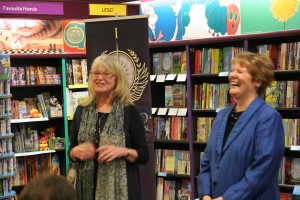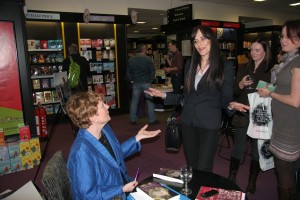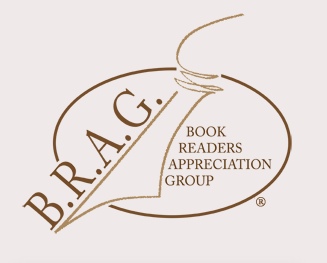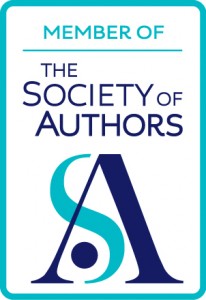 ‘Sit up straight!’ your mother would shriek at you as you hunched over your school homework. You rolled your eyes, then made a feeble effort at complying. If you were taller than everybody else in the playground as I was, your natural position was slumpissimus. ‘Sit up straight!’ your mother would shriek at you as you hunched over your school homework. You rolled your eyes, then made a feeble effort at complying. If you were taller than everybody else in the playground as I was, your natural position was slumpissimus.
As we grew older, it slowly dawned on us that mothers might have known best, but we shrugged it off. Now as supposedly mature adults, we are catching the results of a life of slouching. Well, I am, at least. Today as I go to the diagnostic clinic for my second spine and hip MRI in three years, I realise Mother Was Right.
I suspect that a training accident when I was in uniform hasn’t helped; I jarred my spine when I fell off an assault course. Now I have an uncomfortable time sitting for longer than thirty minutes – most unhelpful for a writer.*(update)
Quite why we walk upright is still under discussion. Now research tells us sitting is going to kill us early.I think the best thing would be to have a nice lie down. But that’s not particularly good for us either as our muscles waste without being used.
We know the benefits that good posture brings:
- Keeps bones and joints in the correct alignment so that muscles are being used properly.
- Helps decrease the abnormal wearing of joint surfaces that could result in arthritis.
- Decreases the stress on the ligaments holding the joints of the spine together.
- Prevents the spine from becoming fixed in abnormal positions.
- Prevents fatigue because muscles are being used more efficiently, allowing the body to use less energy.
- Prevents strain or overuse problems.
- Prevents backache and muscular pain.
- And for the vain among us (including me), it contributes to a good appearance.
 Sadly, many of us failed to implement. Many years ago, our bodies were young and strong. Backache was for old people. Hm. Well, you certainly find out your posture sins when you get older. Sadly, many of us failed to implement. Many years ago, our bodies were young and strong. Backache was for old people. Hm. Well, you certainly find out your posture sins when you get older.
I shall contemplate these as I roll into the maw of the MRI machine today, endure the banging and grinding of all those magnets and the polite but inevitably censorious remarks of the doctors afterwards. In the meantime, I keep taking the painkillers to deaden the pinching pain and try to sit up straight. *(update below)
Hints for sitting on your bottom properly
- Sit up with your back straight and your shoulders back. Your buttocks should touch the back of your chair.
- All three normal back curves should be present while sitting. A small, rolled-up towel or a lumbar roll can be used to help you maintain the normal curves in your back. Here’s how to find a good sitting position when you’re not using a back support or lumbar roll:
- Sit at the end of your chair and slouch completely
- Draw yourself up and accentuate the curve of your back as far as possible. Hold for a few seconds
- Release the position slightly (about 10 degrees). This is a good sitting posture.

- Distribute your body weight evenly on both hips.
- Bend your knees at a right angle. Keep your knees even with or slightly higher than your hips. (use a foot rest or stool if necessary). Your legs should not be crossed.
- Keep your feet flat on the floor.
- Try to avoid sitting in the same position for more than 30 minutes.
- At work, adjust your chair height and work station so you can sit up close to your work and tilt it up at you. Rest your elbows and arms on your chair or desk, keeping your shoulders relaxed.
- When sitting in a chair that rolls and pivots, don’t twist at the waist while sitting. Instead, turn your whole body.
- When standing up from the sitting position, move to the front of the seat of your chair. Stand up by straightening your legs. Avoid bending forward at your waist. Immediately stretch your back by doing 10 standing backbends.
With thanks to Cleveland Clinic online
*2018 Update: Nothing functionally/mechanically wrong – it’s a rampant nerve. After 18 months, I’ve stopped the medication as I didn’t feel well on it and am concentrating on stretches, walking, swimming and massage. Oh, and losing a bit of weight!
Alison Morton is the author of Roma Nova thrillers INCEPTIO, PERFIDITAS, SUCCESSIO, AURELIA, INSURRECTIO and RETALIO. CARINA, a novella, is available for download now. Audiobooks are available for the first four of the series.
Find out more about Roma Nova, its origins, stories and heroines… Get INCEPTIO, the series starter, for FREE when you sign up to Alison’s free monthly email newsletter
If you enjoyed this post, do share it with your friends!Like this:Like Loading...
 Today I’m delighted to welcome Anita Chapman, the genius behind neetsmarketing, an empathic and friendly business dedicated to help authors with their social media. I asked Anita to tell what authors fear most about social media and how to deal with it. Today I’m delighted to welcome Anita Chapman, the genius behind neetsmarketing, an empathic and friendly business dedicated to help authors with their social media. I asked Anita to tell what authors fear most about social media and how to deal with it.
Thank you for inviting me to be a guest on your blog, Alison! These are the main challenges found by my clients and course attendees, and because there’s only so much space here, I’ve kept the information in this post quite general. More specific advice, especially about using Twitter and Facebook can be found in posts on my neetsmarketing blog.
1. Deciding what to go for
When starting out on social media, some authors worry about what to go for: Twitter, Facebook, Instagram, Pinterest, Google+; there are so many options. Start with Twitter and Facebook when building your author platform, and go from there. Remember you can post the same content from all your social media accounts; if you share an article on Twitter about a theme from your novel, it takes a minute to paste that link into your author Facebook Page. In this post, I’ll refer to Twitter and Facebook when talking about social media.
2. Time management
Authors need to produce books, so understandably using precious writing time for social media isn’t always embraced with enthusiasm. On the other hand, some authors find it difficult to tear themselves away from social media, using it as a form of procrastination. It is possible to manage time spent on social media if you schedule some tweets using Tweetdeck (my choice, but some prefer Hootsuite), such as those for cover reveals, book releases, upcoming talks and signings, book launches, blog posts; this keeps everything ticking over when you’re not there, and you can save these tweets to reuse until they’ve expired. Posts on author Facebook Pages can be scheduled too, then when you have chance to drop in to Twitter and Facebook for 20-30 minutes per day, that can be your time to chat, retweet and make your tweets less formal and more ‘you’.
3. Learning how to use
Some authors find social media overwhelming, and the best way to gain confidence on Twitter and Facebook is to set up the accounts, and get stuck in. At the beginning, when you’re learning, you don’t have many followers or Facebook friends anyway, so few people can see what you’re doing. So much can be learnt by observing your peers and idols. What are they tweeting about, what do their tweets look like? What are they posting on their Facebook Pages and on personal Facebook profiles? And who is following them, who are they following? There are some Twitter tips in this post on my blog, recently revamped for 2016: My Beginner’s Guide to Twitter for Writers.
4. Engaging your audience
Do you feel as though you’re speaking and no one is listening? Social media can be like this early on when you don’t have many followers or Facebook friends, but also if you’re not posting content which encourages others to interact with you. Use photos to make tweets, Facebook posts, blog posts more interesting; and make blog post titles enticing. Interact with others and share content by others that fits in with your brand (see below), and they may reciprocate.
5. Building a Brand and Discoverability
I’ve linked these together, as they relate to one another. Finding your potential readers can be a challenge, but social media makes it easier than you’d think.
Brand: Think about what defines you and your books, and aim to focus on those subjects and themes when posting on Twitter and Facebook. Use relevant hashtags so people interested in those subjects and themes can find you (and use other hashtags to build relationships through shared interests). This is a way to gain potential readers as followers.
Discoverability: Find the places where people interested in subjects and themes from your books hang out. Join Facebook Groups, follow and use Twitter hashtags, follow and comment on blogs based around those subjects and themes. Liz Fenwick wrote a post for my blog, Using Twitter to Connect with Readers which gives great examples on how to find your potential readers using Twitter. Ask book bloggers (nicely) if they’ll review your book, and/or host you on their blogs. Ask authors to host you on their blogs too. The more content you post online, the more likely you are to come up in a Google search.
More about Anita

Anita Chapman is a freelance social media manager with clients in the world of books and she runs social media courses for writers (next one is on 7 May in London). She writes historical fiction set in eighteenth century Italy and spent five years on the Romantic Novelists’ Association’s New Writers’ Scheme before becoming an Associate Member in 2016 wearing her neetsmarketing hat. Anita is Social Media Manager for the Historical Novel Society, and Publicity Officer for the next HNS Conference in Oxford, 2-4 September 2016 #HNSOxford16.
(I work alongside Anita as Deputy Publicity Officer for the 2016 Oxford HNS Conference and it’s a great pleasure to have such a knowledgeable and effective colleague.)
Connect with Anita at her neetsmarketing website, visit her neetsmarketing blog on social media for writers and book marketing and her neetswriter blog on writing.
Twitter @neetsmarketing and @neetswriter
Facebook pages: neetsmarketing and Anita Chapman Writer
Thanks for your great insight and advice, Anita!
Alison Morton is the author of Roma Nova thrillers, INCEPTIO, PERFIDITAS, SUCCESSIO and AURELIA. The fifth in the series, INSURRECTIO, will be published on 12 April 2016.
Find out more about Roma Nova, its origins, stories and heroines…
If you enjoyed this post, do share it with your friends!Like this:Like Loading...
 “PDF? No thanks.” “PDF? No thanks.”
How often do you as a writer get that answer back from a possible reviewer, blogger or beta reader? And I can understand it. Truly. My eyes have had enough of squinting at minute text in a silly font when I’ve been asked to read or review a book.
But PDFs (Portable Document Files) are useful. We don’t want to send off our precious Word file, nor do we have our .mobi and ePub files yet. A PDF file resembles a digital photocopy of your Word file, so the font size and type that end up on somebody’s ereader cannot be changed or resized, unlike a Kindle (.mobi) file or an ePub file.
There is a way round this problem and that is to make a readable PDF, i.e. one you don’t need a magnifying glass and a cold wet towel round your forehead to read. I emphasise the word readable in relation to my PDFs when sending them out as we are all sensitised to the grotty versions.
I use Word for Mac but it works the same on a Microsoft Windows machine (I think).
So here is what you do…
In MS Word, take your final, beautiful, edited A4 size file and make a copy with a slightly different filename and save it.
Next, put that new file into single line spacing.
Then select the whole text using Command +A (Ctrl+A in Windows) and once highlighted, select a serif font. I use Cambria rather than horrible Times New Roman. Resize to 24pt.
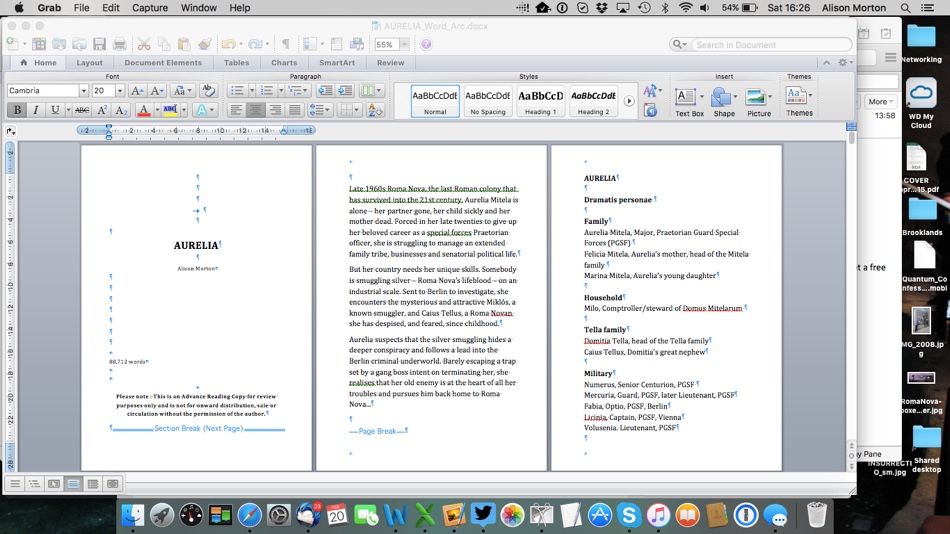
Once you’ve done that, check you’ve put a page break at the end of each chapter, not just line returns. Click the pilcrow ¶, (also called the paragraph mark or paragraph sign) in the formatting line to reveal the breaks, tabs and returns in blue.
Save the file.
Select the following margins for the document: Top 2.9cm, Bottom 3.2cm, left and right 2.1cm. (Update: if you ‘lose’ a line of text at the bottom of the page when you view it on your Kindle, just reduce the side margins to e.g. 1.7cm.)
Display the document on your screen at 25% size to check for empty pages and/or strange formatting.
Go into the footer area and delete page numbers.
Save as before.
Add a disclaimer on the front page such as:
Please note
: This is an Advance Reading Copy for review purposes only and is not for onward distribution, sale or circulation without the permission of the author.
Save.
Save again but this time Save As a .PDF file and save the new .PDF with a similar name to that of the Word file you’ve just been working on but with PDF in the title. It will automatically add the suffix .pdf to denote file type as well.
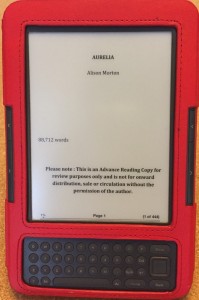
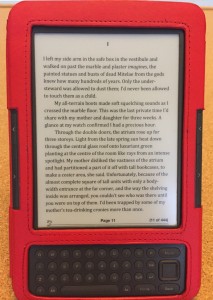
Click through the above photos to get more true to life images.
Send to your own Kindle as a document to check it has come out as you wish. My ereader is an old black and white Kindle Keyboard and this procedure seems to work for me.
Happy PDF creation!
Alison Morton is the author of Roma Nova thrillers, INCEPTIO, PERFIDITAS, SUCCESSIO and AURELIA. The fifth in the series, INSURRECTIO, was published in April 2016.
Find out more about Roma Nova, its origins, stories and heroines…
If you enjoyed this post, do share it with your friends!Like this:Like Loading...
 Today I’m welcoming Fenella Forster, writer extraordinaire. Her debut book, Annie’s Story, set in the early 20th century, came out last year with great enthusiasm and was recently awarded the prestigious B.R.A.G. Medallion. Her second book, Juliet’s Story, has just launched. Both books are part of ‘The Voyagers’ trilogy stretching from 1913 to the present day. Fenella Forster writes non-fiction (from Bad to Wurst and Seller Beware: How not to sell your business) under her real name Denise Barnes. Today I’m welcoming Fenella Forster, writer extraordinaire. Her debut book, Annie’s Story, set in the early 20th century, came out last year with great enthusiasm and was recently awarded the prestigious B.R.A.G. Medallion. Her second book, Juliet’s Story, has just launched. Both books are part of ‘The Voyagers’ trilogy stretching from 1913 to the present day. Fenella Forster writes non-fiction (from Bad to Wurst and Seller Beware: How not to sell your business) under her real name Denise Barnes.
Welcome Fenella!
Writers often have ‘second book blues’ when they worry if the second is as good as their first. How did you find writing and publishing Juliet’s Story?
This was easier than it might have been, because these two novels started life as one. It was to be called ‘The Voyagers’ and was to be a dual time-line – the story of Annie set in the early 20th century interwoven with the story of Juliet, the granddaughter, set in the present.
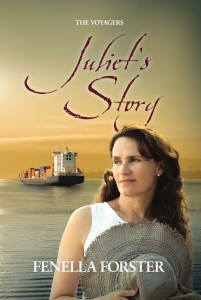 I eventually finished the manuscript at 150,000 words – far too long for any agent or publisher to risk taking on a debut author. Undeterred, I began writing the sequel about another family member, Kitty. When a couple of agents suggested I split the first book into two separate stories I was beside myself. But you learn not to be too precious in the writing world. You’ll remember, Alison, it was you who said: ‘Split Annie and Juliet, then Kitty becomes the third book in the trilogy.’ (Remember it well!) I eventually finished the manuscript at 150,000 words – far too long for any agent or publisher to risk taking on a debut author. Undeterred, I began writing the sequel about another family member, Kitty. When a couple of agents suggested I split the first book into two separate stories I was beside myself. But you learn not to be too precious in the writing world. You’ll remember, Alison, it was you who said: ‘Split Annie and Juliet, then Kitty becomes the third book in the trilogy.’ (Remember it well!)
You can’t imagine how spurred on I was to think I was writing a trilogy. Trouble was, Juliet was fine at 100,000 words, but Annie was way too light. I ended up almost writing another book for her. So Books 1 & 2 of the trilogy were written together, you might say – hence no deep worry about whether the second novel would be as good.
Publishing Juliet’s Story was a breeze. It went the same way as Annie’s Story – straight to SilverWood Books, the brilliant all-encompassing service for indie authors.
Juliet’s Story is part of a series called The Voyagers. Tell us more about the series.
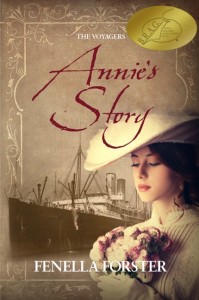 The trilogy begins in 1913 with Annie’s Story. She’s a housemaid in a fine country house in Norfolk, recently engaged to Ferguson, a footman from a neighbouring house. He springs it on her that they should go to Australia ‘to better themselves’. Annie knows her place is to follow her husband-to-be or break off the engagement so she decides to take the risk. The voyage out throws up new problems for Annie to deal with, not to mention Alexander Townsend, the handsome ship’s doctor. And once they are in Melbourne, Ferguson finds it difficult to stick to his promises. I’d better not say anymore! The trilogy begins in 1913 with Annie’s Story. She’s a housemaid in a fine country house in Norfolk, recently engaged to Ferguson, a footman from a neighbouring house. He springs it on her that they should go to Australia ‘to better themselves’. Annie knows her place is to follow her husband-to-be or break off the engagement so she decides to take the risk. The voyage out throws up new problems for Annie to deal with, not to mention Alexander Townsend, the handsome ship’s doctor. And once they are in Melbourne, Ferguson finds it difficult to stick to his promises. I’d better not say anymore!
In Book 2, Juliet’s Story, it’s in 2005 Juliet, Annie and Ferguson’s granddaughter, is a careworn businesswoman who has a passionate longing to go to Australia. There, she believes the secret she holds close to her heart might be resolved. But how can she ever get away? An ex-client provides her with the opportunity and Juliet boards a freighter, mainly in deference to her grandparents – they wouldn’t have enjoyed the kind of luxury modern passenger ships provide – and also it seems more of an adventure. However, she doesn’t reckon on meeting the enigmatic Jack Delaney, one of the six passengers… I’m going all fuzzy so I’ll stop there!
In Book 3, Kitty’s Story, we drop back to 1941. Kitty is the youngest of Annie’s children. She’s seventeen when the story opens, and her only dream is to become a singer like her idol Vera Lynn. She joins ENSA and is sent to Cairo. There, singing to the soldiers in the desert, she meets the man who will change her life forever. Ruggero Andreotti is a high-ranking Italian prisoner-of-war, with a passion for opera – and for Kitty. But Kitty has to face a terrible choice between the conflicting demands of her duty and her heart.
The epilogue ties up the whole trilogy, though each book can be read as a stand alone.
So what’s next for you?
My fourth novel is a complete breakaway from the sweeping sagas and I’ve already written the second draft.

It’s a rom-com set in 1975, loosely based on one of the experiences in my own life when I was a chauffeuse (we used the feminine terms in those days) to a multi-millionaire Swiss tax lawyer. I lived in his house on Lake Zurich near a small village. So Ashley, my heroine, does the same. But instead of her boss being plain and elderly – as mine was – hers is quite dishy, though rather serious, leading Ashley to fall for his even more handsome fun-loving brother Benvenuto. There are lots of misunderstandings but you’ll have to read it to find out if it all comes out right in the end.
One lonely rom-com didn’t seem enough so I’ve started another, where my heroine goes off to Beijing on the Trans-Siberian Express. I’ve done this same trip so unfortunately don’t have to do much research. Shame.
Thanks so much for inviting me as a guest on your blog, Alison. I always enjoy your posts, and this has really been fun to do.
Thank you for being my guest and good luck with Kitty’s Story and The Lies.

Juliet’s Story available now from
Amazon UK Amazon US Kobo B&N Nook
Alison Morton is the author of Roma Nova thrillers, INCEPTIO, PERFIDITAS, SUCCESSIO and AURELIA
Find out more about Roma Nova, its origins, stories and heroines…
If you enjoyed this post, do share it with your friends!Like this:Like Loading...
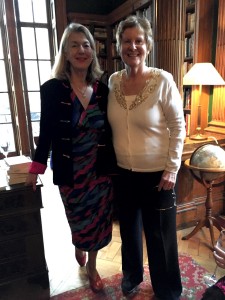 Last week, I had the enormous pleasure of attending book launches for two writing friends. On Saturday 23 January, I drank bubbly, ate scones and cake with Denise Barnes who launched her second book, Juliet’s Story, at the University Women’s Club. The magnificent library was a perfect setting for us to hear about the research behind Denise’s book and to have a glimpse into her writing journey, some of which I shared with her. Last week, I had the enormous pleasure of attending book launches for two writing friends. On Saturday 23 January, I drank bubbly, ate scones and cake with Denise Barnes who launched her second book, Juliet’s Story, at the University Women’s Club. The magnificent library was a perfect setting for us to hear about the research behind Denise’s book and to have a glimpse into her writing journey, some of which I shared with her.
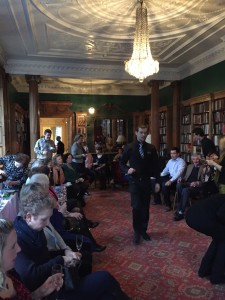
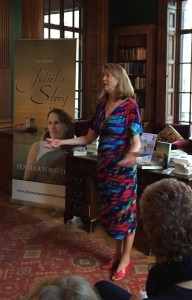
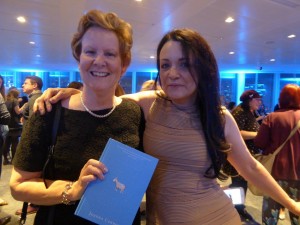
A few days later, I was off to Harper Collins’ incredibly impressive offices to share Jo Cannon’s triumph as she launched her much acclaimed The Trouble with Goats and Sheep.

I remember the three of us cowering in a corner at the 2010 Festival of Writing in York. We were rather over-awed by the famous names, too scared to pitch to agents, but eager to go to classes, workshops and learn as much as possible. After a glass of Dutch courage, aka wine, we actually approached some people!
We’ve all three come on a bit from there…
So, launches – why, what and how?
However you’re published, there are similarities and differences. Denise’s launch was a celebration amongst friends, fellow writers, her publisher, Helen Hart of SilverWood Books, and supporting relatives, all taking in the atmosphere in a rather lovely traditional Mayfair club.
Jo’s launch was organised by her publisher, The Borough Press, part of Harper Collins. It was glamorous and smart, but still very personal. Jo explained that everybody present had been invited because they had supported her by an act of kindness. She has hundreds if not thousands of fans, so all of us there felt very honoured.
But both authors mingled beforehand and then, out in front of their audiences, gave a personal account of why they’d written their book and a little about the characters and story. Both authors’ work was on sale to keen fans!
Although Jo’s event was organised by the Harper Collins ‘machine’ with plenty of support staff, she had undertaken an enormous amount of social media work to publicise her book beforehand. As an indie, Denise had the responsibility of organising her event herself with the splendid support of the University Women’s Club team, plus social media tweeting and posting by her and her friends, including yours truly.
So whatever your publishing route, what do you need to do when you launch?
1. Don’t wait to start planning. Although a beautiful book is a pre-requisite, you must think about where, how and when as soon as you’re even thinking of publishing your book.
2. Network in real life at conferences, courses and events, and virtually on Twitter and Facebook. Try and meet as wide a circle of people as possible. Apart from the pleasure of talking with new people and learning new things, you may come across one or more published authors in your genre or known specialists in your field. Ask them for their thoughts, their advice, but in a polite way. Who knows, they may come to your launch and add some magic dust.
3. If you are thinking of a bookshop launch, go and buy some books there and become known to the staff. Make an appointment to go and see the owner or events manager. Be business-like.
4. Before making an approach, ensure your publisher has already loaded your book on to Nielsen Bookdata so that the shop staff can check you are a pukka author. Have your Bookseller Information Sheet in your hand and a good quality business card with your contact details. Prepare your ideas for getting the audience in – your friends and more importantly, the general public – and how you’re going to publicise the event. And if you have got a ‘name’ to agree to come along to your launch, mention this as part of your pitch.
5. Publicise your book’s publication date on social media with cover reveal, the blurb, posts about the setting/background short extracts and your motivation for writing the book. However, don’t give too much away!
6. Invite your guests in good time; people have very busy schedules. About four weeks to six weeks ahead is a good balance. Invite about a third to a half as many again as your target for this very reason.
7. The key to a successful evening is, rather predictably, preparation. Write your talk, speak it aloud, condense it on to cards, but practise it. Make sure the launch venue has glasses/plates/bowls or take your own. Do offer a drink, both alcoholic and soft. You don’t need fancy canapés (although the food at both the above launches was wonderful!); good supermarket nibbles are fine. Take plenty of postcards (you can put one on each chair beforehand), bookmarks, pens etc. and a guest book. And task somebody to take photos!
And at the event itself, smile. The audience has come to see you. They want to hear what you have to say, they want to take photos, especially one with you. And they can be incredibly lovely when they queue with their book for you to sign.
Alison Morton is the author of Roma Nova thrillers, INCEPTIO, PERFIDITAS, SUCCESSIO and AURELIA
Find out more about Roma Nova, its origins, stories and heroines…
If you enjoyed this post, do share it with your friends!Like this:Like Loading...
|
Subscribe to Blog via Email
Join 50 other subscribers.
Categories
Archive
|
 ‘Sit up straight!’ your mother would shriek at you as you hunched over your school homework. You rolled your eyes, then made a feeble effort at complying. If you were taller than everybody else in the playground as I was, your natural position was slumpissimus.
‘Sit up straight!’ your mother would shriek at you as you hunched over your school homework. You rolled your eyes, then made a feeble effort at complying. If you were taller than everybody else in the playground as I was, your natural position was slumpissimus. Sadly, many of us failed to implement. Many years ago, our bodies were young and strong. Backache was for old people. Hm. Well, you certainly find out your posture sins when you get older.
Sadly, many of us failed to implement. Many years ago, our bodies were young and strong. Backache was for old people. Hm. Well, you certainly find out your posture sins when you get older.














